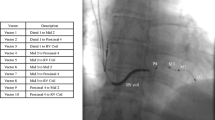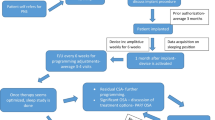Abstract
Purpose
Central sleep apnea (CSA) is a highly common comorbidity in heart failure (HF) patients and is known to deteriorate quality of life and prognosis. Effective treatment options are scarce. Transvenous phrenic nerve stimulation (PNS) has been shown to be effective and safe in CSA treatment in HF. However, lead implantation may be difficult or fail due to anatomical or technical challenges. We report novel and innovative approaches applying different interventional techniques to enhance PNS implantation success, allowing otherwise missing CSA treatment.
Methods
Twenty-seven consecutive HF patients (86% male, mean age: 69 ± 11 years; reduced left ventricular ejection fraction in 16 patients (57%)) were included in this study who were unable to tolerate or had contraindications for mask-based therapy. We evaluated PNS total implantation success, procedural characteristics, and feasibility and success rates of intravascular interventions to facilitate PNS lead implantation in otherwise ineffective procedures.
Results
Seven lead implantation attempts (24%) required additional intravascular interventional action to facilitate successful implantation, mainly consisting of balloon angioplasties to allow optimal PNS lead placement. Two procedures remained unsuccessful and two patients underwent a second procedure due to stimulation side effects and lead fracture respectively. All over, no complications resulted from application of interventional techniques to achieve a 93% implantation success rate.
Conclusion
Transvenous PNS lead placement for CSA treatment can be difficult and challenging. However, interventional intravascular techniques markedly increase implantation success and thereby allow application of this therapy for effective CSA treatment in most patients without additional complications.




Similar content being viewed by others
References
Fox H, Purucker HC, Holzhacker I, Tebtmann U, Bitter T, Horstkotte D, Graml A, Woehrle H, Oldenburg O (2016) Prevalence of sleep-disordered breathing and patient characteristics in a coronary artery disease cohort undergoing cardiovascular rehabilitation. J Cardiopulm Rehabil Prev 36:421–429. https://doi.org/10.1097/HCR.0000000000000192
Oldenburg O, Wellmann B, Buchholz A, Bitter T, Fox H, Thiem U, Horstkotte D, Wegscheider K (2016) Nocturnal hypoxaemia is associated with increased mortality in stable heart failure patients. Eur Heart J 37:1695–1703. https://doi.org/10.1093/eurheartj/ehv624
Omran H, Bitter T, Horstkotte D, Oldenburg O, Fox H (2018) Characteristics and circadian distribution of cardiac arrhythmias in patients with heart failure and sleep-disordered breathing. Clin Res Cardiol 107:965–974. https://doi.org/10.1007/s00392-018-1269-4
Fox H, Bitter T, Horstkotte D, Oldenburg O (2017) Sleep-disordered breathing and arrhythmia in heart failure patients. Sleep Med Clin 12:229–241. https://doi.org/10.1016/j.jsmc.2017.01.003
Gessner V, Bitter T, Horstkotte D, Oldenburg O, Fox H (2017) Impact of sleep-disordered breathing in patients with acute myocardial infarction: a retrospective analysis. J Sleep Res 26:657–664. https://doi.org/10.1111/jsr.12540
Oldenburg O, Arzt M, Börgel J, Penzel T, Skobel CE, Fox H, Schöbel C, Bitter T, Stellbrink C (2017) Addendum zum Positionspapier “Schlafmedizin in der Kardiologie. Update 2014”. Somnologie 21:51–52. https://doi.org/10.1007/s11818-017-0104-x
Oldenburg O, Fox H, Bitter T, Horstkotte D (2017) Adaptive servoventilation to treat sleep-disordered breathing in cardiac patients. Somnologie 21:82–83. https://doi.org/10.1007/s11818-017-0100-1
Oldenburg O, Fox H, Wellmann B, Thiem U, Horstkotte D, Bitter T (2017) Automatic positive airway pressure for treatment of obstructive sleep apnea in heart failure. Somnologie 21:273–280. https://doi.org/10.1007/s11818-017-0124-6
Costanzo MR, Ponikowski P, Coats A, Javaheri S, Augostini R, Goldberg LR, Holcomb R, Kao A, Khayat RN, Oldenburg O, Stellbrink C, McKane S, Abraham WT, remede System Pivotal Trial Study G (2018) Phrenic nerve stimulation to treat patients with central sleep apnoea and heart failure. Eur J Heart Fail 20:1746–1754. https://doi.org/10.1002/ejhf.1312
Costanzo MR, Ponikowski P, Javaheri S, Augostini R, Goldberg L, Holcomb R, Kao A, Khayat RN, Oldenburg O, Stellbrink C, Abraham WT, remede System Pivotal Trial Study G (2016) Transvenous neurostimulation for central sleep apnoea: a randomised controlled trial. Lancet 388:974–982. https://doi.org/10.1016/S0140-6736(16)30961-8
Fox H, Bitter T, Horstkotte D, Oldenburg O, Gutleben KJ (2017) Long-term experience with first-generation implantable neurostimulation device in central sleep apnea treatment. Pacing Clin Electrophysiol 40:498–503. https://doi.org/10.1111/pace.13049
Augostini R (2012) A novel approach to the treatment of central sleep apnea in patients with heart failure. Herzschrittmacherther Elektrophysiol 23:9–13. https://doi.org/10.1007/s00399-011-0165-7
Abraham WT, Jagielski D, Oldenburg O, Augostini R, Krueger S, Kolodziej A, Gutleben KJ, Khayat R, Merliss A, Harsch MR, Holcomb RG, Javaheri S, Ponikowski P, remede Pilot Study I (2015) Phrenic nerve stimulation for the treatment of central sleep apnea. JACC Heart Fail 3:360–369. https://doi.org/10.1016/j.jchf.2014.12.013
Gutleben KJ, Nolker G, Marschang H, Sinha AM, Schmidt M, Ritscher G, Brachmann J (2008) Rescue-stenting of an occluded lateral coronary sinus branch for recanalization after dissection during cardiac resynchronization device implantation. Europace 10:1442–1444. https://doi.org/10.1093/europace/eun266
Oto A, Aytemir K, Okutucu S, Canpolat U, Sahiner L, Ozkutlu H (2012) Percutaneous coronary sinus interventions to facilitate implantation of left ventricular lead: a case series and review of literature. J Card Fail 18:321–329. https://doi.org/10.1016/j.cardfail.2012.01.003
Zucchelli G, Bongiorni MG, Di Cori A, Soldati E, Solarino G, Fabiani I, Segreti L, De Lucia R, Viani S, Coluccia G, Paperini L (2012) Cardiac resynchronization therapy after coronary sinus lead extraction: feasibility and mid-term outcome of transvenous reimplantation in a tertiary referral centre. Europace 14:515–521. https://doi.org/10.1093/europace/eur339
Worley SJ, Gohn DC, Pulliam RW (2009) Goose neck snare for LV lead placement in difficult venous anatomy. Pacing Clin Electrophysiol 32:1577–1581. https://doi.org/10.1111/j.1540-8159.2009.02573.x
Nath RK, Raj A, Parvatagouda C, Pandit N (2016) Veno-venous loop through coronary sinus for LV lead placement during cardiac resynchronization therapy. Indian Heart J 68(Suppl 2):S212–S215. https://doi.org/10.1016/j.ihj.2016.02.023
Author information
Authors and Affiliations
Corresponding author
Ethics declarations
Conflict of interest
Klaus-Jürgen Gutleben has received honoraria for lectures and proctoring from Respicardia Inc., Minnetonka, MN, USA. All the other authors have no conflict of interest to declare regarding the content of this study.
Research involving human participants and/or animals
All procedures performed in this study involving human participants were in accordance with the ethical standards of the institutional research committee and with the 1964 Helsinki declaration and its later amendments or comparable ethical standards. No animals are involved in this research.
Informed consent
This retrospective analysis of implantation procedures involves data exploration of humans that had the remede system implanted and gave their written informed consent. In addition to that, approval for conducting this study was obtained by our local ethics committee beforehand.
Additional information
Publisher’s note
Springer Nature remains neutral with regard to jurisdictional claims in published maps and institutional affiliations.
Rights and permissions
About this article
Cite this article
Gutleben, KJ., Fox, H., Sommer, P. et al. Interventional techniques to increase implantation success of transvenous phrenic nerve stimulation for central sleep apnea treatment. Sleep Breath 24, 905–912 (2020). https://doi.org/10.1007/s11325-019-01917-0
Received:
Revised:
Accepted:
Published:
Issue Date:
DOI: https://doi.org/10.1007/s11325-019-01917-0




